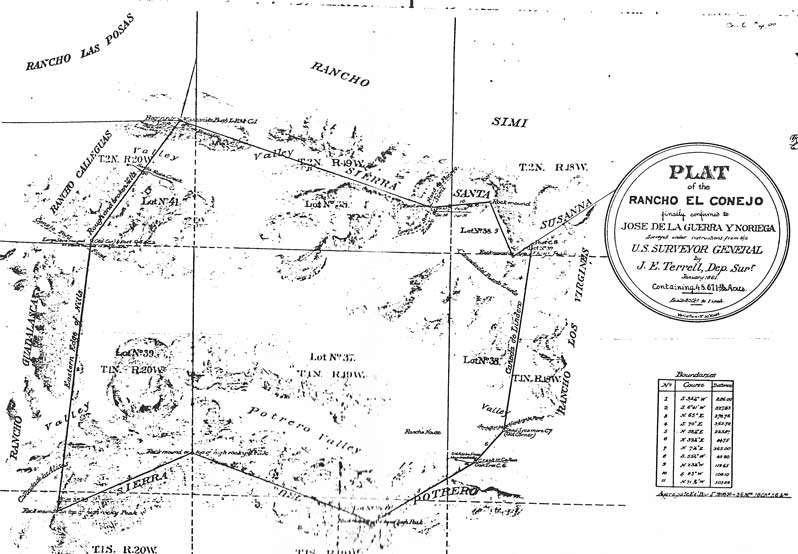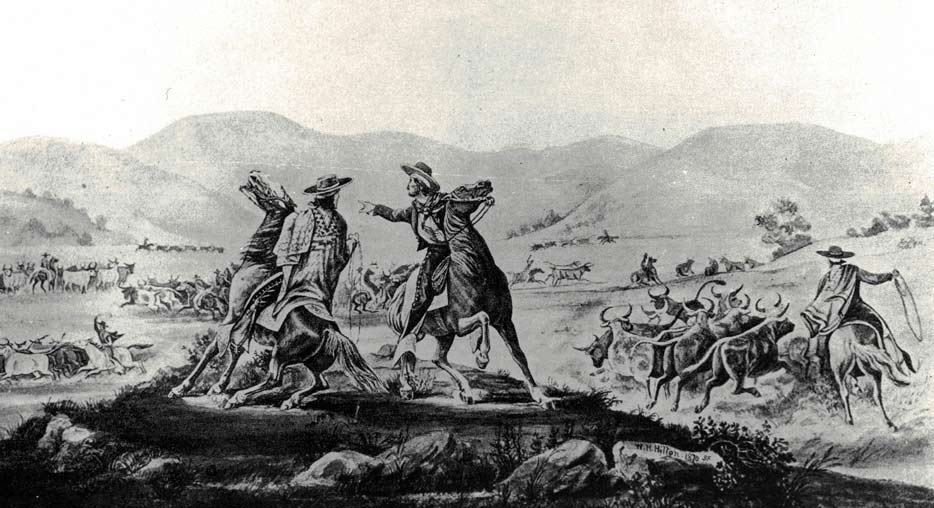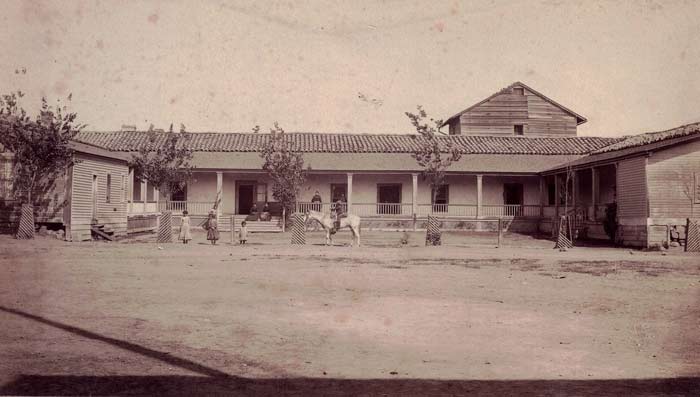By Andy Ludlum, Museum Volunteer
Don José De la Guerra y Noriega was known to everyone as “El Capitán.” He was already one of the richest men in California in 1822 when he petitioned the last Spanish governor to grant him one half of Rancho El Conejo.

Land grants were given to men who had served the crown faithfully. De la Guerra was an officer in the Spanish army in Mexico for 52 years before he retired to spend the last 16 years of his life ranching on nearly half a million acres of California land that he had received “in consideration of his merits and services.” His land reached from San Luis Obispo in the north to what is now the Los Angeles County line. It included several ranchos in Ventura County – Rancho Las Posas, Rancho Simi and half of Rancho El Conejo.

The economy of Rancho El Conejo was all about cattle. But steers were prized for their hides and tallow and not so much for their meat. Beef had so little value that cattle carcasses were often left to rot in the sun. There was a custom that hungry travelers could butcher one of the free-roaming animals provided they left the hide behind. Hides were soaked in salt water for one or two days to soften. They were scraped to remove any remaining flesh and then stretched out in the sun to dry. The fat of the steer was boiled to render tallow which was poured into hide bags for shipment.
The hides and tallow were hauled by wagon to Hueneme to waiting trade ships. The hides were prized in the booming leather goods market, especially New England shoe factories. Hides sold for $1 in the 1820s, $2 in the 1830s and in the 1840s the price of hides peaked at $3 to $5. By the 1840s de la Guerra was selling $100,000 of hides and tallow every year. That would be about $2.9 million in 2019. Hides were treated as money since currency was in short supply in California. Contracts and promissory notes were paid in hides. Judges even imposed fines and judgements in hides. The exchange of hides became so common, they came to be known as “California bank notes.”
El Capitán sold his hides and tallow for gold. His ranchos were in what was then a remote area, so taking his riches to a bank was impractical. Instead, he added a two-story, A-framed attic to his Santa Barbara adobe, from where he administered his sprawling ranchos. The attic counting house had no staircase and could only be reached by ladder. The cautious Don stored the ladder in his bedroom, so it was out of reach when the money room was not in use. Inside the room were two old-fashioned Spanish chairs surrounded by canvas bags and large open baskets, brimming with gold coins. The huge baskets were compactly-woven Native American baskets known as “coras.” The Don’s largest cora, thought to contain a half bushel of Mexican and Spanish gold doubloons would be worth over $750,000 today.
Occasional visitors, like ship captains, were astonished to see that much gold in the possession of one man in a place where wealth was usually gauged by the number of horses and cattle. Don José had little reason to spend his gold coins except for what he purchased from the visiting trading ships. He ran his own “company store”, stocked with the necessities needed to run his ranchos. He paid his vaqueros, or cowboys, in goods as they had little use for money on the out-of-the-way ranchos.

Despite his best security efforts, Don Jose’s gold was not safe from his mischievous sons. The Don’s boys were often described by family and friends as “a little wild.” But, with quiet determination, the legend holds that they climbed up to the roof of the counting house and crawled slowly across the clay tiles, dragging long poles with them. Near the peak of the roof, the boys pried off two or three of the tiles. Looking inside, they saw the brilliant stash of the old Don’s gold below them. The boys dipped the ends of the long poles in sticky beef tallow. They then reached down into the open baskets and drew up the gold pieces that stuck to the end of the poles. The boys took as many gold coins as they thought wouldn’t be noticed. How often their operation was repeated and how much of the old man’s treasure disappeared will never be known. Don José finally found out what his sons were up to and put a stop to their sticky tricks. But, as Don José never knew how much money he had, he was never sure how much he had lost.
Ironically, it was gold that began to bring an end to the California hide and tallow industry. When gold was discovered in Sutter’s Mill in 1848, tens of thousands of hungry miners poured into Northern California and the demand for beef skyrocketed. Cattle prices soared to $75 a head in San Francisco. By 1855, most of the easily-recoverable gold was gone. Most of the prospectors left in search of more lucrative strikes and with them went the demand for beef.
Nature took its toll in the 1860s. Thousands of cattle drowned in catastrophic floods in 1862. Then, with severe drought in 1863 and 1864, many more animals died due to lack of food and water. All this brought an end to the era of the great ranchos. Most were divided and sold to pioneer families for less than $1 an acre. When El Capitán died in 1858 at age 79, he left an estate valued at $200,000, over $6 million today. His ranchos had 12,000 cattle, 1,000 horses and 5,000 sheep. Within a year of Don José’s death, his estate became such a mismanaged, financial mess that most of his properties had to be sold off by his family. Rancho El Conejo was among the last to break up in the 1870s. De la Guerra’s half of Rancho El Conejo was sold in 1872 to John Edwards and Howard Mills. Over the years, the men acquired all but 5,000 acres of the original rancho. Edward’s land included most of what is now Newbury Park and Thousand Oaks. Mill’s land included what became known as Westlake Village and Hidden Valley.
Make History!
Support The Museum of Ventura County!
Membership
Join the Museum and you, your family, and guests will enjoy all the special benefits that make being a member of the Museum of Ventura County so worthwhile.
Support
Your donation will help support our online initiatives, keep exhibitions open and evolving, protect collections, and support education programs.
Bibliography – Stealing Gold from the Old Don of Rancho El Conejo
- Bidwell, Carol A. The Conejo Valley, Old and New Frontiers. Windsor Publications, Inc., 1989. Conejo Valley Historical Society. “Conejo Valley Days,” A History of Conejo Valley. Farland Enterprises, 1966.
- Holland, Georgana. Hispanic Influence in Conejo Valley. Conejo Valley Historical Society, Hispanic History Series, 1978.
- Redmond, Michael. “Question: “What was the hide and tallow trade?”.” Santa Barbara Independent. 2007. https://www.independent.com/2007/11/08/question-what-was-hide-and-tallow-trade/.
- Thompson, Fr. Joseph A. El Gran Capitan, José De la Guerra, A Historical Biographical Study. Franciscan Fathers of California Corporation, 1961.
- Wikipedia. “California Hide Trade.” n.d. https://en.wikipedia.org/wiki/California_hide_trade.

